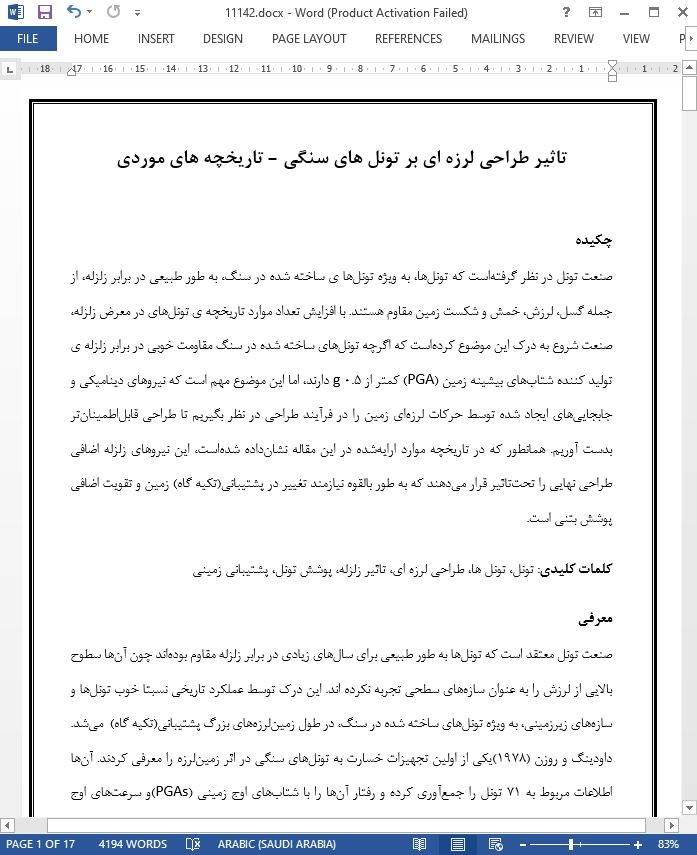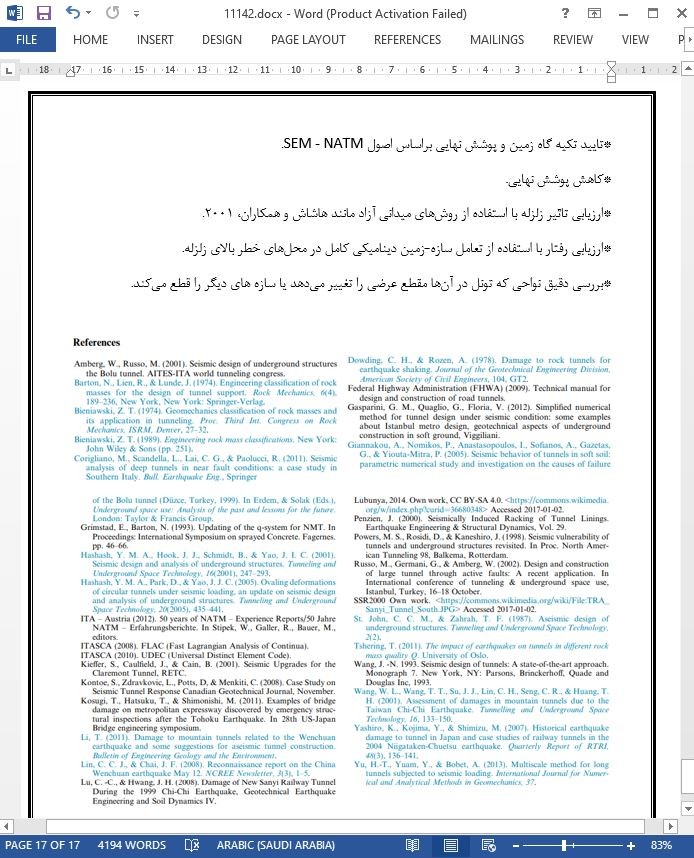
تاثیر طراحی لرزه ای بر تونل های سنگی - تاریخچه های موردی
چکیده
صنعت تونل در نظر گرفتهاست که تونلها، به ویژه تونلها ی ساخته شده در سنگ، به طور طبیعی در برابر زلزله، از جمله گسل، لرزش، خمش و شکست زمین مقاوم هستند. با افزایش تعداد موارد تاریخچه ی تونلهای در معرض زلزله، صنعت شروع به درک این موضوع کردهاست که اگرچه تونلهای ساخته شده در سنگ مقاومت خوبی در برابر زلزله ی تولید کننده شتابهای بیشینه زمین (PGA) کمتر از ۰.۵ g دارند، اما این موضوع مهم است که نیروهای دینامیکی و جابجاییهای ایجاد شده توسط حرکات لرزهای زمین را در فرآیند طراحی در نظر بگیریم تا طراحی قابلاطمینانتر بدست آوریم. همانطور که در تاریخچه موارد ارایهشده در این مقاله نشانداده شدهاست، این نیروهای زلزله اضافی طراحی نهایی را تحتتاثیر قرار میدهند که به طور بالقوه نیازمند تغییر در پشتیبانی(تکیه گاه) زمین و تقویت اضافی پوشش بتنی است.
معرفی
صنعت تونل معتقد است که تونلها به طور طبیعی برای سالهای زیادی در برابر زلزله مقاوم بودهاند چون آنها سطوح بالایی از لرزش را به عنوان سازههای سطحی تجربه نکرده اند. این درک توسط عملکرد تاریخی نسبتا خوب تونلها و سازههای زیرزمینی، به ویژه تونلهای ساخته شده در سنگ، در طول زمینلرزههای بزرگ پشتیبانی(تکیه گاه) میشد. داودینگ و روزن (۱۹۷۸)یکی از اولین تجهیزات خسارت به تونلهای سنگی در اثر زمینلرزه را معرفی کردند. آنها اطلاعات مربوط به ۷۱ تونل را جمعآوری کرده و رفتار آنها را با شتابهای اوج زمینی (PGAs)و سرعتهای اوج زمین (PGV)مقایسه کردند.
نتایج
این مرور کوتاه از متون و بررسی سوابق موردی خاص نویسنده نشان میدهد که تونلهای ساخته شده در سنگ ها عموما قادر به ایستادگی در برابر زلزله متوسط بدون نیاز به اصلاح طرحهای خود هستند. با این حال، برای افزایش قابلیت اطمینان سازه ی تونل و تطبیق حوادث بزرگتر در فواصل نزدیکتر، لازم است اثر بارهای دینامیکی ایجاد شده توسط زلزله در نظر گرفته شود.
Abstract
The tunnel industry has considered that tunnels, especially tunnels in rock, are naturally resistant to earthquake action, including faulting, shaking, deflection and ground failure. As the number of case histories of tunnels subject to earthquake action has increased, the industry has started to recognize that, although tunnels in rock have good resistance against earthquakes generating peak ground accelerations (PGA) lower than 0.5 g, it is important to include the dynamic forces and displacements generated by seismic ground motions in the design process to obtain a more reliable design. These additional earthquake forces impact the final design, potentially requiring changes to the ground support and additional reinforcement of the concrete lining, as illustrated by case histories presented in this paper.
Introduction
The tunnel industry considered that tunnels were naturally resistant to earthquake action for many years, as they did not experience the same high levels of shaking as surface structures. This perception was supported by the relative good historic performance of tunnels and underground structures, especially of tunnels in rock, during large earthquakes. Dowding and Rozen (1978) presented one of the first compilations of damage to rock tunnels due to earthquake shaking. They collected information on 71 tunnels and compared their behavior with estimated peak ground accelerations (PGAs) and peak ground velocities (PGVs).
Conclusions
This brief review of literature and review of specific case histories the author has been involved in indicate that tunnels in rock generally are capable of withstanding moderate earthquake events without the need to modify their designs. However, to increase the reliability of the tunnel structure and to accommodate larger events at closer distances, it is necessary to consider the effect of the dynamic loads generated by earthquakes.
چکیده
معرفی
تاثیر زلزله بر روی تونلها
حرکات زمین
جابجاییهای گسل
طراحی لرزهای تونلها
پشتیبانی(تکیه گاه) زمینی
پوشش نهایی
تاریخچه موردی
حفاری متعارف
طراحی مسیر تونل درامانارد - منطقه ی گسلی مادرید جدید
خروجی سد - بزرگی 6.5 در 0.1 کیلومتر ، بزرگی 7.5 در 2 کیلومتر
راهحل فرم بسته
راهحل عددی
مقایسه ی نتایج
حفاری TBM
تونل حمل و نقل - زلزله منطقه ای
نتایج
Abstract
Introduction
Impact of earthquakes on tunnels
Ground motions
Fault displacements
Seismic design of tunnels
Ground support
Ground support
Case histories
Conventional excavation
Drumanard Tunnels Tender Design – New Madrid Fault Zone
Dam Outlet – Magnitude 6.5 at 0.1 km, Magnitude 7.5 at 2 km
Closed form solution
Numerical solution
Comparison of results
TBM excavation
Conclusions
- اصل مقاله انگلیسی با فرمت ورد (word) با قابلیت ویرایش
- ترجمه فارسی مقاله با فرمت ورد (word) با قابلیت ویرایش، بدون آرم سایت ای ترجمه
- ترجمه فارسی مقاله با فرمت pdf، بدون آرم سایت ای ترجمه



